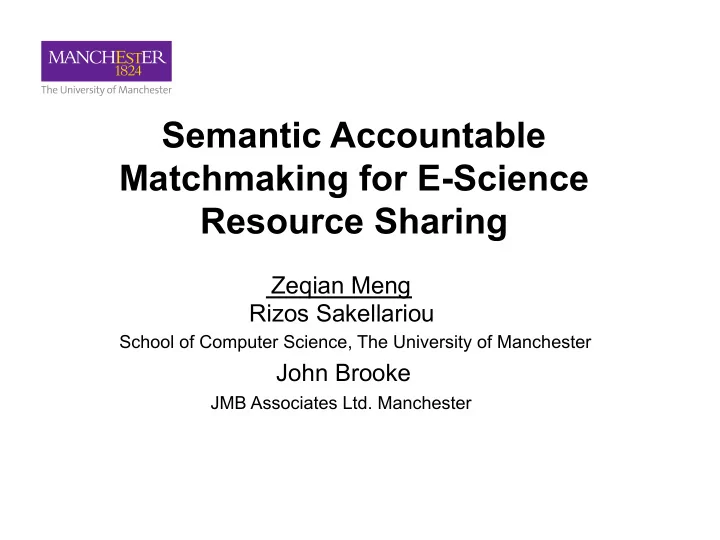

Semantic Accountable Matchmaking for E-Science Resource Sharing Zeqian Meng Rizos Sakellariou School of Computer Science, The University of Manchester John Brooke JMB Associates Ltd. Manchester
Introduction | Motivation resource sharing management for e- Scientists’ collaboration e-Scientists resource supplying infrastructures
Introduction | Motivation Present open market for The Science technical twists Cloud [1] partly via standards Future Past dynamic resource isolated supply via open infrastructures standards [1]: Amsaghrou, Rachida. Report On The Open Market Consultation And The Results. Geneva: CERN, 2016. Web. 29 June 2016.
Introduction | Motivation resource sharing resource supplying management for e- organisation Scientists’ collaboration e-Scientists resource requesting resource supplying organisation infrastructures
Introduction | Motivation centralized resource management and allocation * e-Science infrastructures * 1.*access* request* 2.*resource* request** e"Scien'sts* resource management and e-Science infrastructures * allocation for a research group * 1* 2* [2] e"Scien'sts* [2]: Solagna, Peter. "AAI In EGI Current Status". 2015. Presentation.
Introduction | Motivation dynamic & customised resource supply fine-grained accountable resource sharing (per job) coarse-grained resource management
Introduction | Motivation complex(( rela+onships( Distributed(management(very( hard(or(impossible( VO(defines(complex(SLA(between( members(and(resources.(E.g.:(each(VO( member(gets(10k(cpuh/month(or(all( members(can(run(up(to(10(copies(of( licensed(siDware(simutaneously.( dynamic( sta+c( VO(does(not(offer(sophis+cated( SLAs,(etc.(VO(membership(is( used(mostly(to(grant(access(to( some(resources((which(are( UVOS%% subject(to(change)(( distributed%mgmt% Distributed(management( possible( gLite/VOMS%% minimal( No%distributed% rela+onships( mgmt% Classification of Virtual Organizations [3] [3]: Benedyczak, K. and Ba ł a, P., 2012. The next generation of Virtual Organisations in UNICORE. Unicore Summit .
Introduction | Main question How to realise fine-grained accountable resource sharing? centralized resource management and allocation * e-Science infrastructures * 1.*access* request* resource management and 2.*resource* allocation for a research group * request** e-Science infrastructures * 2.*access* e"Scien'sts* request** 1.*resource* resource management and request* e-Science infrastructures * allocation for a research group * e"Scien'sts* 1* 2* e"Scien'sts*
Contributions • A standard-based information model for fine-grained resource management • An implementation of the information model ( independent organizations, new lifecycle )
Methodology • Extension upon GLUE 2.0 (Glue Laboratory Uniform Environment 2.0) • Semantic modeling & reasoning • Implementation upon Amazon Web Sevices
Results | Semantic model OWL 2 (Web Ontology Language 2) Share hasMappingPolicy hasAdminDomain hasAppEnvironment hasProviderDomain hasService hasUserDomain needLib hasApp hasQueue hasAppEnvironment hasExeEnvironment hasExeEnvironment hasPaymentMethod hasOSFamily hasMiddleware measurement mem hasResource hasOSFamily hasEndpoint physicalCpus hasCpuModel cpuTime clockSpeed hasResource hasCpuModel clockSpeed
Results | Semantic reasoning Pellet: open source, Java-based UserName AppName ! belongToShare GroupName User ! hasMappingPolicy CPUTime belongToUserDomain request hasUserDomain (balance) hasMember IndividualCPUTime Access verified TotalCPUTime hasApp PhysicalCPUs hasAppEnvironment hasCPUModel hasOSFamily hasExeEnvironment ClockSpeed Share services hasResource search PhysicalCPUs hasExeEnvironment hasService Services in CPUTime Share cannot hasCPUModel meet demands hasOSFamily hasExeEnvironment hasService ClockSpeed hasResource
Results | Implementation Implementation design Collaborated Provider AWS ! e#Scien(st!A! Share .owl ! Group Management ! Provider A ! UserB, group ! e#Scien(st!B! Base .owl ! app ! ! resource details ! Service .owl Mapping Policy .owl ! Provider B ! e#Scien(st!C! ! Service .owl
Results | Evaluation ✔ Functionalities: -- application- & resource-oriented matchmaking -- balance updates -- no resources returned with un-sufficient balance -- members’ privileges for matchmaking
Results | Evaluation ✔ Performance: pure reasoning duration -- a group with 15 members -- 2 instances for application-oriented matchmaking -- 4 instances for resource-oriented matchmaking
Results | Evaluation ✔ Performance: pure reasoning duration -- application- & resource-oriented matchmaking (S1&S2) -- balance updates (S1) -- no resources returned with un-sufficient balance (S3) -- members’ privileges for matchmaking (S5) Scenario 1 2 3 5 Mean (ms) 267.10 279.33 272.93 280.83 Devea5on (ms) 74.45 74.37 72.54 59.11
Conclusion • A semantic model extended from GLUE 2.0 • Reasoning programs upon the model • Evaluation over Amazon Web Sevices • Testbed: negotiable and accountable resource sharing
Hypotheses • To form and dissolve resource supply in a dynamic & independent manner • Fine-grained accountable resource sharing • To allow analysis of algorithms for performance
References [1] Amsaghrou, Rachida. Report On The Open Market Consultation And The Results. Geneva: CERN, 2016. Web. 29 June 2016. [2] Solagna, Peter. "AAI In EGI Current Status". 2015. Presentation. [3] Benedyczak, K. and Ba ł a, P., 2012. The next generation of Virtual Organisations in UNICORE. Unicore Summit .
Contact : Zeqian Meng zeqian.meng@manchester.ac.uk
Recommend
More recommend